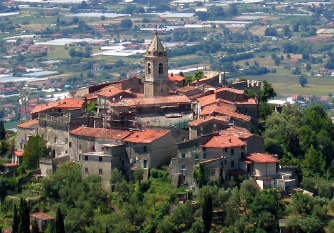The oldest villages in Camaiore date back to the High Middle Age, in a parchment from 984 where they were mentioned as Vilae. Some of them became independent towns, but then they were annexed to the town of Camaiore and, with the unification of Italy, they finally became part of the town’s territory.

Monteggiori
Monteggiori, first mentioned in 1224, was a feudal castle and it belonged to the noble families of Bozzano and Montemagno; we now can see just the urban map, some ruins of the walls and the fortress.
In 1308 this village was annexed to Pietrasanta and then, from the XVI century, to Camaiore. In its territory both Castruccio Castracani and Paolo Guinigi decided to build their residential palaces.
Greppolungo
This small village was, in ancient times, connected to a castle, and it leans on a rock which faces all Camaiore and the sea of Versilia. A lot of excursionists, who want to walk along the paths which lead to M. Gabberi, choose this place as a destination.
Casoli
Casoli, leaning on the right side of the Lombricese torrent, was first inhabited in 984. From the main square you can enjoy a breathtaking view of the Apuan Alps.
Just above this small villages you can walk through the oaths which lead to Mount Matanna and Mount Prana.
Metato
Metato, placed on the east part of Camaiore and facing the sea, is the one with the best climate among all the other villages. The origin of its name leads back to the presence of a peculiar dryer for chestnuts, called “metato”.
It has been inhabited since the XIV century.
Even though it doesn’t count many inhabitants in winter time, lots of people from nearby villages go there on Sunday, and during the summer a big amount of foreign tourists moves there.
Lombrici
Its origin leads back to 1083, because of its connection to Saint Biagio’s Church, which still preserves the typical characteristics of the Romanic architecture. Near Candalla, at 200 metres distance, we can find Ferriera Barsi, where we can see a still functionin hydrohamer.
Pieve
It is so called because of the presence of the Pieve Church, one among the 5 ones in Versilia. It was first built in honour of Saint Mary and Saint Stephen, and then of Saint John the Baptist. Inside this church there is still a sarcophagus found in Lombrici, dating back to II century A.C.
Nocchi
This village was already famous in 810, thanks to its church, Saint Peter of “Noccle"’s church. Via Francigena, built upon an old roman street, crossed this village, as several archaeological discoveries show.
Between the XVII century and the XVIII century, some noblemen from Lucca decided to build some palaces, like Villa Montecatini or Villa Peruzzi, which are definitely worth a visit.
Its history spins around the important presence of olive crushers and mills, placed along the Lucchese torrent, which can still be visited today.
Pontemazzori
Placed at a certain height, this village is just 300 metres away from Saint Andrew’s Church, mentioned in 885. It went under Camaiore’s control in 1308. It’s mainly known for Villa Giannini, which belonged to Trenta’s family (a noble family from Lucca).
Montemagno
It has its origins in the X century, and a hundred years ago it had already built up a church, in honour of Saint Michael. Via Francigena walked through this village, which ten led to Nocchi and, lastly, Camaiore.
In Montemagno you can still visit the ruins of the walls, of a water thank and of the façade of Saint Bartolomeo’s church, which were all part of the Montemagno Castle. This castle was home of one the most important families of Lucca, “Montemagnesi Family”.
Gombitelli
Gombitelli is well known for its stud production and for being a linguistic island (a place with several spoken languages ). Unfortunately, we have just a few witnesses of this language, if not none. However, it could be indentified as a dialect coming from Northern Italy, where the Gombitelli family came from.
Here you can visit an interesting palace from the XVII century, which belonged to the Cerù family, some remains of a castle belonged to the Montemagnesi noblemen, mentioned in a 1029 parchment, at 400 metres distance from the village.
Orbicciano
Before being ruled by the town of Camaiore, this village had already been under control of the Seimiglia district of Lucca.
Thanks to some old documents, we know that Orbicciano already exsisted in the IX and X century. Saint George’s church, mentioned in 967, still preserves, inside its bell tower, a bell from 1271.
S. Maria Albiano Castello
Its origins comes from a feudal castle built in the XI century, although today it’s hidden among the houses of the small village. An interesting manor, which belonged to the Borromei family, can be visited here.
Along with Fibbiano and Orbicciano, this village became part of the town of Camaiore in 1617.
Fibbiano
Among the countries that once were a part of the Seimiglia district this is the one which is located in the highest position. As a medieval village, Fibbiano still retains the architectural aspects of the past: from the streets to the façades, built with just smooth stones, which are in perfect harmony with the green of the surrounding landscape. Near Fibbiano, at Passo del Lucese, there’s a wonderful Romanesque church originally dedicated to Saint Cataldo, then to Saint James. Around the thirteenth century, next to the church a hospice was built to welcome pilgrims and travelers, who traveled along the road leading to Garfagnana. Not far from the Passo del Lucese there’s a cave, at the bottom of which in 1978 the Archaeological Camaiore Group found a neolithic burial, unearthed a decade later by the Archeological Museum of Camaiore. The recovered materials are now preserved in the Museo Civico di Camaiore.
Fibbialla
Its origins date back to the ninth century, and since the twelfth century it became a part of the Jura possessions of the Canons of St. Martin of Lucca, who built a castle there in 1123, of which just a few ruins remain. In 1799, with the suppression of Jura of the canons, commissioned by the temporary French government, Fibbialla was included in the town of Camaiore.
Pedona
The village was built in the area anciently occupied by a feudal castle belonged to the Flammi di Pedona nobleman, a secondary branch of the powerful family of feudal lords of Montemagno. The urban structure of this village still shows the shape of the castle, which was equipped with a circular tower and mighty walls. A second tower built in 1324 by Castruccio Castracani was used by the Republic of Lucca until the seventeenth century. as a lookout point, from which, in case of danger, help signals were sent to Vecoli, and from Vecoli to Lucca. Pedona offers an impressive view: from the valley of Camaiore to the sea.
S.Lucia
S. Lucia was an ancient and picturesque village called Vegghiatoia or Vegliatoia, referring to the dominant position, from where you could monitor the area below and above the marina. It was a part for some time the Vicariate of Pietrasanta, but then, from the sixteenth century, along with Monteggiori, it was included in the Vicariate of Camaiore.

